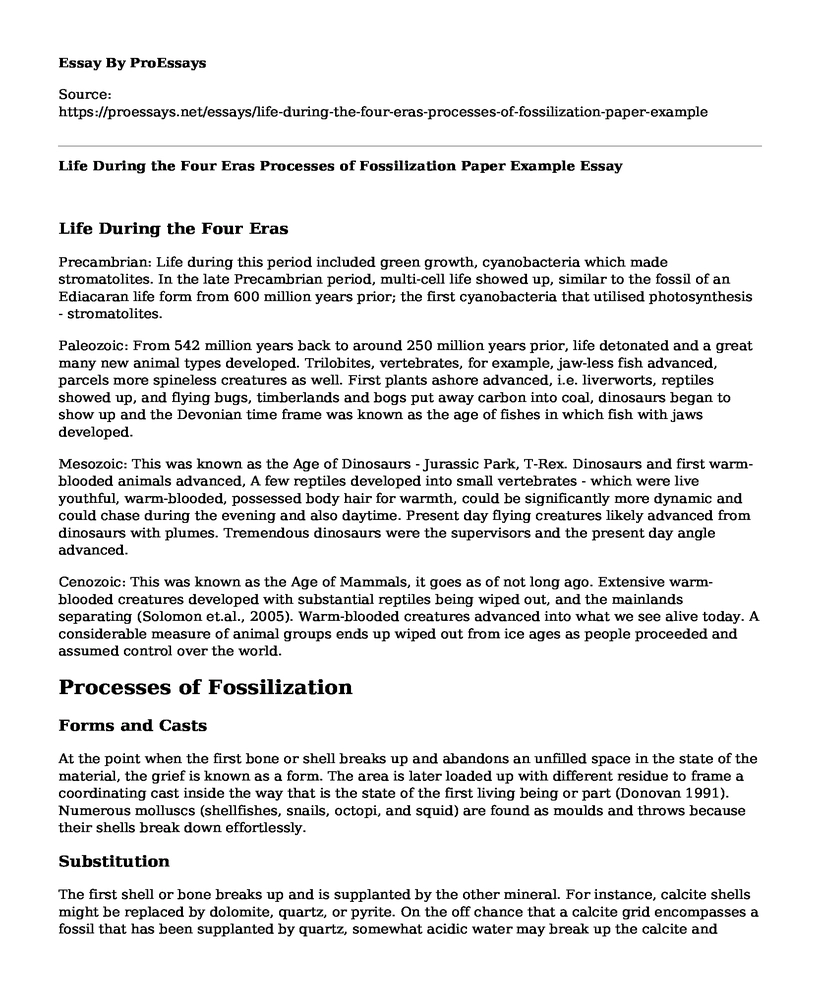Life During the Four Eras
Precambrian: Life during this period included green growth, cyanobacteria which made stromatolites. In the late Precambrian period, multi-cell life showed up, similar to the fossil of an Ediacaran life form from 600 million years prior; the first cyanobacteria that utilised photosynthesis - stromatolites.
Paleozoic: From 542 million years back to around 250 million years prior, life detonated and a great many new animal types developed. Trilobites, vertebrates, for example, jaw-less fish advanced, parcels more spineless creatures as well. First plants ashore advanced, i.e. liverworts, reptiles showed up, and flying bugs, timberlands and bogs put away carbon into coal, dinosaurs began to show up and the Devonian time frame was known as the age of fishes in which fish with jaws developed.
Mesozoic: This was known as the Age of Dinosaurs - Jurassic Park, T-Rex. Dinosaurs and first warm-blooded animals advanced, A few reptiles developed into small vertebrates - which were live youthful, warm-blooded, possessed body hair for warmth, could be significantly more dynamic and could chase during the evening and also daytime. Present day flying creatures likely advanced from dinosaurs with plumes. Tremendous dinosaurs were the supervisors and the present day angle advanced.
Cenozoic: This was known as the Age of Mammals, it goes as of not long ago. Extensive warm-blooded creatures developed with substantial reptiles being wiped out, and the mainlands separating (Solomon et.al., 2005). Warm-blooded creatures advanced into what we see alive today. A considerable measure of animal groups ends up wiped out from ice ages as people proceeded and assumed control over the world.
Processes of Fossilization
Forms and Casts
At the point when the first bone or shell breaks up and abandons an unfilled space in the state of the material, the grief is known as a form. The area is later loaded up with different residue to frame a coordinating cast inside the way that is the state of the first living being or part (Donovan 1991). Numerous molluscs (shellfishes, snails, octopi, and squid) are found as moulds and throws because their shells break down effortlessly.
Substitution
The first shell or bone breaks up and is supplanted by the other mineral. For instance, calcite shells might be replaced by dolomite, quartz, or pyrite. On the off chance that a calcite grid encompasses a fossil that has been supplanted by quartz, somewhat acidic water may break up the calcite and abandon a wonderfully safeguarded quartz fossil.
Pressure
A few fossils shape when their remaining parts are compacted by high weight, abandoning a dim engraving. Stress is most usual for fossils of leaves and greeneries, yet can happen with different creatures.
Saved Remains
Most remarkable is the conservation of delicate tissue unique material. Creepy crawlies have been saved flawlessly in golden, which is old tree sap. Mammoths and a Neanderthal seeker were solidified in ice sheets, permitting researchers the rare chance to look at their skin, hair, and organs. Researchers gather DNA from these remaining parts and contrast the DNA arrangements with those of current partners.
Permineralization
The most well-known technique for fossilisation is permineralization. After a bone, wood part, or shell is covered in silt, mineral-rich water travels through the dregs. This water stores minerals into void spaces and creates a fossil. Permineralization framed fossil dinosaur bones, petrified wood, and numerous marine fossil (Courtillot 2002).
Mass Extinction Causes
i.Disastrous methane release
ii.Surge basalt discharges
iii.Environmental change
iv.Effect events; for example when the planet is struck by a comet or meteor.
References
Courtillot, V. (2002). Evolutionary Catastrophes: The science of mass extinction. Cambridge: Cambridge Univ. Press.
Donovan, S. K. (1991). The Processes of fossilisation. New York: Columbia University Press.
Solomon, E. P., Berg, L. R., & Martin, D. W. (2005). Biology. Estados Unidos: Thomson Learning, Inc.
Cite this page
Life During the Four Eras Processes of Fossilization Paper Example. (2022, Jul 15). Retrieved from https://proessays.net/essays/life-during-the-four-eras-processes-of-fossilization-paper-example
If you are the original author of this essay and no longer wish to have it published on the ProEssays website, please click below to request its removal:
- Harrison H. Schmitt and William Happer: In Defense of Carbon Dioxide
- Comparison Between Julius Caesar and Abraham Lincoln Essay
- The Depiction of Roman Culture in the Gladiator (2000) Film Essay
- Essay Sample on American, French, and Industrial Revolutions
- Treaty of Amiens and Treaty of Tilsit Essay Example
- Understanding Social Theory: Explaining Human Interactions & Forming Hypotheses - Essay Sample
- Essay Sample on Exploring Old, Weird America with Frederick Law Olmsted







